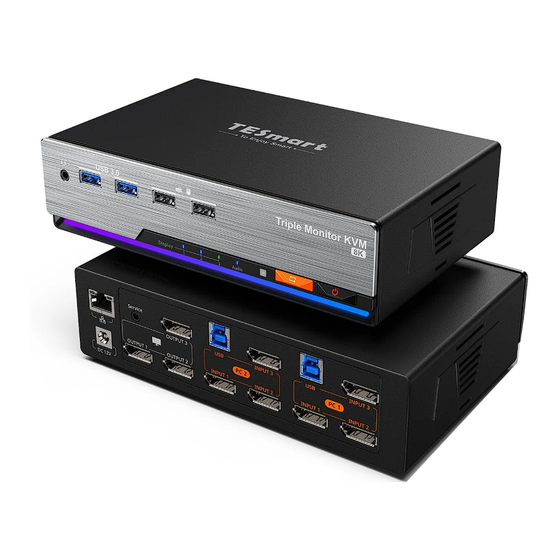
Table of Contents
Advertisement
Quick Links
Advertisement
Table of Contents

Summarization of Contents
Safety Tips and Warnings
General Safety Precautions
Provides essential safety guidelines for using the KVM switch, including keeping it away from water and heat.
Battery Description
Remote Control Battery Installation
Explains that the remote control requires AAA batteries and provides caution for lithium battery disposal.
Warranty Information
Product Warranty Terms
Details the one-year warranty period for defects and conditions for repair or replacement.
Preface
Introduction to the KVM Switch
Introduces the 2x3 DP Triple Monitor KVM Switch, highlighting its features and benefits.
Features
Key Product Capabilities
Lists the main features, including multi-monitor support, resolution, OS compatibility, and USB 3.2.
Packing List
Included Components
Enumerate all items included in the product package, such as the KVM switch, cables, and adapters.
Panel Description
Front Panel Layout (Ports 1-4)
Details the front panel components, including audio/mic, USB 3.0 ports, and status indicators.
Front Panel Layout (Ports 5-8)
Continues front panel description, covering audio/USB indicator, selection button, power switch, and LED strip.
Rear Panel Connections (Ports 9-11)
Describes rear panel ports like DC 12V, LAN, and IR extension.
Rear Panel Outputs (Ports 12-13)
Explains the DP outputs and KVM input ports group on the rear panel.
Connection Description
Connection Diagram
Provides a visual overview of how to connect the KVM switch to computers and peripherals.
Connection Preparation
Outlines essential steps and considerations before physically connecting the KVM switch.
Connecting PC and Displays
Details the process of connecting PCs to the KVM via USB and DP cables, and displays to KVM outputs.
Connecting Peripherals
Explains how to connect external keyboards, mice, and USB 3.0 devices to the KVM.
Audio and Network Connection
Covers connecting audio devices and network cables to the KVM switch.
Power Connection and Completion
Describes connecting the power adapter and final steps to power on the KVM switch.
KVM Workbench Example
Shows a typical setup of a fully connected KVM workbench with multiple monitors.
Function Description
Display Modes Overview
Explains the two main display modes: duplicate/extend and displaying different PCs on monitors.
Display Settings and Tips
Offers guidance on setting up display modes and managing multi-display configurations in the OS.
Keyboard and Mouse Modes
Details the Pass Through and Legacy Emulation modes for keyboard and mouse compatibility.
Built-in Network Switch
Explains the function of the integrated USB Ethernet adapter for gigabit network connections.
EDID Emulator Functionality
Describes how EDID emulators maintain correct display information and window positions.
Mouse Wheel Switching
Explains how to use the mouse wheel to switch between input sources.
Operation Method
Front Panel Button Switching
Explains how to switch input sources using the KVM's front panel buttons.
IR Remote Control Usage
Details the functions of the IR remote control for operating the KVM.
Keyboard Hot Keys - Input Switching
Covers keyboard hot keys for selecting previous/next input ports and specific ports.
Keyboard Hot Keys - Display Modes
Explains hot keys for switching PCs on different monitors and managing KM focus.
Keyboard Hot Keys - Mode Management
Details hot keys for follow mode, audio/USB channels, and keyboard/mouse emulation modes.
Keyboard Hot Keys - Feature Control
Covers hot keys for network card, EDID emulator, and mouse wheel switching.
Keyboard Hot Keys - Buzzer Sound
Explains how to enable or disable the buzzer sound using keyboard hot keys.
Keyboard Hot Keys - Lighting Modes
Details hot keys for controlling KVM lighting effects and modes.
Change Hot Key Combinations
Custom Hotkey Setup Methods
Describes two methods for setting custom hotkey trigger keys for KVM commands.
















Need help?
Do you have a question about the DKS203-M24 and is the answer not in the manual?
Questions and answers